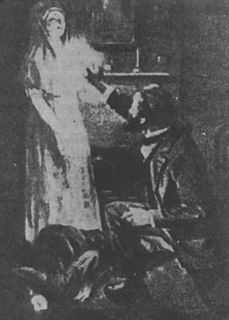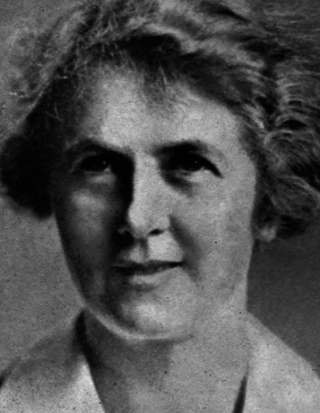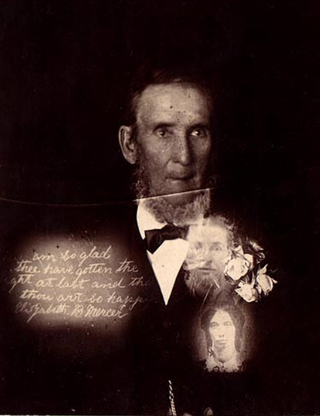

The Society for the Study of Supernormal Pictures (SSSP) was a short-lived psychical organization that formed in 1918 to investigate claims of spirit photography. It was established as a rival to the Society for Psychical Research. [1] [2]


The Society for the Study of Supernormal Pictures (SSSP) was a short-lived psychical organization that formed in 1918 to investigate claims of spirit photography. It was established as a rival to the Society for Psychical Research. [1] [2]
The first President of the SSSP was physician Abraham Wallace. Henry Blackwell, Arthur Conan Doyle and W. G. Mitchell were Vice-Presidents. [3] [4]
According to photographer Martyn Jolly, "The SPR successfully exposed as frauds several spirit photographers supported by the SSSP." [5] One of these was the photographer William Hope. [4]
Members of the SSSP such as Arthur Conan Doyle and honorary secretary Fred Barlow stated that the photographs of the Cottingley Fairies were genuine. [6] In May, 1920 the organization reported that they had obtained evidence for paranormally produced photographs under test conditions. This opinion was rejected by other psychical researchers and in 1923 the organization dissolved. [3]
Barlow was originally supportive of spirit photography but later reversed his opinion. In 1933 he co-authored a paper in the Proceedings of the Society for Psychical Research that cast doubt on the subject and demonstrated fraudulent methods that William Hope and other photographers had utilized. [7]
Barlow's collection of spirit photographs was given to Eric Dingwall who annotated them for the British Library. In 1960, he commented that the collection was evidence of "human stupidity, credulity and superstition". [8]

The Society for Psychical Research (SPR) is a nonprofit organisation in the United Kingdom. Its stated purpose is to understand events and abilities commonly described as psychic or paranormal. It describes itself as the "first society to conduct organised scholarly research into human experiences that challenge contemporary scientific models." It does not, however, since its inception in 1882, hold any corporate opinions: SPR members assert a variety of beliefs with regard to the nature of the phenomena studied.

Spiritualism is the metaphysical school of thought opposing physicalism and also is the category of all spiritual beliefs/views from ancient to modern. In the long nineteenth century, Spiritualism became most known as a social religious movement according to which the laws of nature and of God include "the continuity of consciousness after the transition of death" and "the possibility of communication between those living on Earth and those who have made the transition". The afterlife, or the "spirit world", is seen by spiritualists not as a static place, but as one in which spirits continue to evolve. These two beliefs—that contact with spirits is possible, and that spirits are more advanced than humans—lead spiritualists to a third belief: that spirits are capable of providing useful insight regarding moral and ethical issues, as well as about the nature of God. Some spiritualists will speak of a concept which they refer to as "spirit guides"—specific spirits, often contacted, who are relied upon for spiritual guidance. Emanuel Swedenborg has some claim to be the father of Spiritualism. Spiritism, a branch of spiritualism developed by Allan Kardec and today practiced mostly in Continental Europe and Latin America, especially in Brazil, emphasizes reincarnation.

A séance or seance is an attempt to communicate with spirits. The word séance comes from the French word for "session", from the Old French seoir, "to sit". In French, the word's meaning is quite general: one may, for example, speak of "une séance de cinéma". In English, however, the word came to be used specifically for a meeting of people who are gathered to receive messages from ghosts or to listen to a spirit medium discourse with or relay messages from spirits. In modern English usage, participants need not be seated while engaged in a séance.

In spiritualism, paranormal literature and some religions, materialization is the creation or appearance of matter from unknown sources. The existence of materialization has not been confirmed by laboratory experiments. Numerous cases of fraudulent materialization demonstrations by mediums have been exposed.

Nicolas Camille Flammarion FRAS was a French astronomer and author. He was a prolific author of more than fifty titles, including popular science works about astronomy, several notable early science fiction novels, and works on psychical research and related topics. He also published the magazine L'Astronomie, starting in 1882. He maintained a private observatory at Juvisy-sur-Orge, France.

Mediumship is the practice of purportedly mediating communication between familiar spirits or spirits of the dead and living human beings. Practitioners are known as "mediums" or "spirit mediums". There are different types of mediumship or spirit channelling, including séance tables, trance, and ouija.

Thoughtography, also called projected thermography,psychic photography,nengraphy, and nensha(Japanese: 念写), is the claimed ability to "burn" images from one's mind onto surfaces such as photographic film by parapsychic means. While the term "thoughtography" has been in the English lexicon since 1913, the more recent term "projected thermography" is a neologism popularized in the 2002 American film The Ring, a remake of the 1998 Japanese horror film Ring.

Mina "Margery" Crandon was a psychical medium who claimed that she channeled her dead brother, Walter Stinson. Investigators who studied Crandon concluded that she had no such paranormal ability, and others detected her in outright deception. She became known as her alleged paranormal skills were touted by Sherlock Holmes author Sir Arthur Conan Doyle and were disproved by magician Harry Houdini. Crandon was investigated by members of the American Society for Psychical Research and employees of the Scientific American.

Spirit photography is a type of photography whose primary goal is to capture images of ghosts and other spiritual entities, especially in ghost hunting. It dates back to the late 19th century. The end of the American Civil War and the mid-19th Century Spiritualism movement contributed greatly to the popularity of spirit photography. Photographers such as William Mumler and William Hope ran thriving businesses taking photos of people with their supposed dead relatives. Both were shown to be frauds, but "true believers", such as Sir Arthur Conan Doyle, refused to accept the evidence as proof of a hoax.

William Hope was a pioneer of so-called "spirit photography". Based in Crewe, England, he was a member of the well known spiritualists group, the Crewe Circle. He died in Salford hospital on 8 March 1933.

Ectoplasm is a term used in spiritualism to denote a substance or spiritual energy "exteriorized" by physical mediums. It was coined in 1894 by psychical researcher Charles Richet. Although the term is widespread in popular culture, there is no scientific evidence that ectoplasm exists and many purported examples were exposed as hoaxes fashioned from cheesecloth, gauze or other natural substances.

Eleanor Mildred Sidgwick, known as Nora to her family and friends, was a physics researcher assisting Lord Rayleigh, an activist for the higher education of women, Principal of Newnham College of the University of Cambridge, and a leading figure in the Society for Psychical Research.
The American Society for Psychical Research (ASPR) is the oldest psychical research organization in the United States dedicated to parapsychology. It maintains offices and a library, in New York City, which are open to both members and the general public. The society has an open membership, anyone with an interest in psychical research is invited to join. It maintains a website; and publishes the quarterly Journal of the American Society for Psychical Research.
Estelle Roberts was a British Spiritualist medium.

Eva Carrière, also known as Eva C, was a fraudulent materialization medium in the early 20th century known for making fake ectoplasm from chewed paper and cut-out faces from magazines and newspapers.

Franek Kluski, real name Teofil Modrzejewski (1873-1943), was a Polish physical medium criticized by trained magicians and skeptics as a fraud. Kluski was best known for his séances in which alleged "spirit" molds of hands materialized. It was later demonstrated by Massimo Polidoro and chemist Luigi Garlaschelli that these molds could have easily been made by fraudulent methods.

Edward Arthur Sanders Wyllie was a British medium and spirit photographer.

Kathleen Goligher was an Irish spiritualist medium. Goligher was endorsed by engineer William Jackson Crawford who wrote three books about her mediumship, but was exposed as a fraud by physicist Edmund Edward Fournier d'Albe in 1921.

Édouard Isidore Buguet (1840–1901) was a French medium and spirit photographer.

Richard Boursnell was a British medium and spirit photographer.